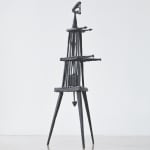Geoffrey Clarke British, 1924-2014
59 1/2 x 22 1/8 x 22 1/8 in
Further images
In the early to mid-1950s Clarke used iron, stained glass, enamel and printmaking techniques to create linear images of Man. Clarke then began making a number of important discoveries casting in aluminium. In the 1950s he successfully experimented with making models of his sculptures in the then-relatively new material of polystyrene, and direct casting in aluminium. This process was relatively inexpensive in comparison to casting in bronze, and produced sculptures of lighter weight. Public commissions came thick and fast. Clarke’s dual success in both stained glass and sculpture was marked by a series of significant exhibitions and commissions in the 1950s and 60s.
In 1965, he had a major retrospective at the Redfern Gallery, London and his work was included in British Sculpture in the 1960s exhibition at the Tate Gallery. He was selected for British Sculptors ‘72 curated by Bryan Kneale at the Royal Academy of Arts and for British Sculpture in the Twentieth Century at the Whitechapel Art Gallery in 1981. His work is held in many prestigious public and private collections around the world.
In 2017, to co-inside with a major retrospective held at the gallery, Pangolin London published the artist’s highly anticipated Catalogue Raisonné written by Clarke's biographer, Dr Judith LeGrove.
Pangolin London represents the estate of Geoffrey Clarke.
Provenance
From the artist's estate.
Exhibitions
Geoffrey Clarke: A Retrospective, 2017; Masterpiece London 2017
Towards a New World: Sculpture in Post-War Britain, Marlborough Gallery, London March 16 - April 22, 2023
Literature
Geoffrey Clarke Sculptor: Catalogue Raisonne By Dr Judith Le Grove, 2017, pg.33
Publications
Geoffrey Clarke Sculptor: Catalogue Raisonne By Dr Judith Le Grove, 2017, pg.33








